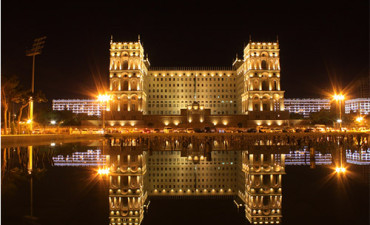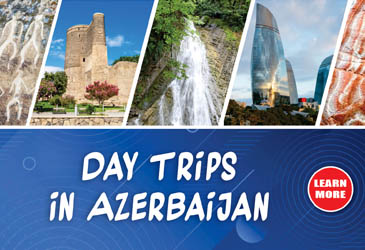Highest Mountains In Azerbaijan
In this article, we will explore the subject of the highest mountains in Azerbaijan. The country is a captivating land of magnificent mountains that irresistibly attract adventurers and nature enthusiasts from all corners of the globe. The country's awe-inspiring landscape is predominantly characterized by the breathtaking Greater Caucasus Mountains, an expansive range that spans across Azerbaijan and stands as a testament to nature's grandeur. These majestic mountains not only enhance the visual splendor of the country but also offer an abundance of opportunities for outdoor activities and exhilarating exploration, leaving visitors spellbound by their sheer magnificence.
For those seeking adventure and adrenaline, the Greater Caucasus Mountains are a paradise waiting to be explored. Hiking trails wind through lush valleys and ascend to dizzying heights, allowing intrepid explorers to immerse themselves in the untouched wilderness. Mountaineers are beckoned to conquer the challenging peaks, pushing their limits and experiencing the thrill of scaling new heights. The mountains also provide a playground for winter sports enthusiasts, with their slopes blanketed in pristine snow, offering a perfect setting for skiing, snowboarding, and more.
The List Of The Highest Mountains In Azerbaijan
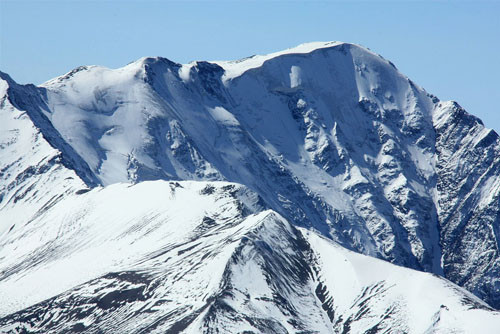
Mount Bazarduzu
Mount Bazarduzu, the highest mountain in Azerbaijan, with its breathtaking beauty and formidable presence, it has become an emblem of Azerbaijan's rich natural heritage. Rising to an elevation of 4,466 meters (14,652 feet), Mount Bazarduzu proudly claims the title of the highest peak in Azerbaijan. Located near the border with Russia, it offers a stunning panorama of the surrounding landscape, including picturesque valleys, dense forests, and glistening glaciers. This mighty mountain serves as a testament to the geological wonders that shape Azerbaijan's diverse topography.
If you're interested in experiencing a hiking adventure tour to Bazarduzu Peak, we recommend checking out the details Bazarduzu Peak Hiking Adventure Tour.
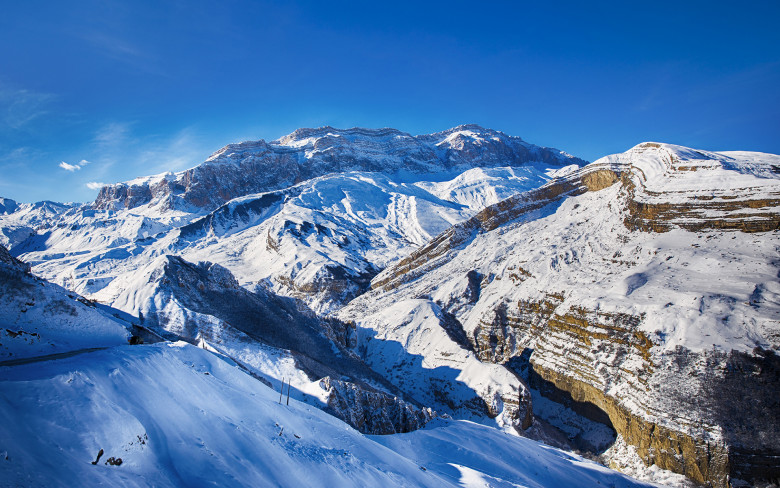
Mount Shahdag
The snowy kingdom, attracting with the crowns of its peak, is truly one of the most extraordinary mountains not only in Azerbaijan, but throughout the Caucasus. The Northern part of Azerbaijan. The etymology of the name comes from the Persian word “shah” which means the king, and the Turkic–originated word “dag” – “mountain”. Shahdag is the peak of the Great or Lateral Ridge in the Southeast of the Greater Caucasus with the height of 4,243 meters (13, 920 ft). In the west of Shahdag, on an altitude of three and a half kilometers, there are two blue lakes. From time to time, severe floods occur there.
Don't miss this opportunity to conquer the heights and discover the hidden treasures of Shahdag. Check out the details of our Shahdag Peak Hiking Tour and start your adventure today.
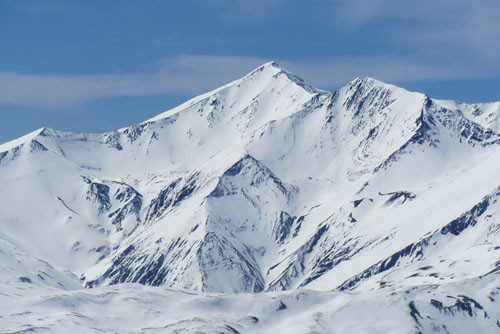
Mount Tufandag
Tufandag Mount, also known as Tufandag Summit, is one of the highest mountain in Azerbaijan. Located in the northwestern part of the country near the city of Gabala, Tufandag stands at an impressive elevation of 4,191 meters (13, 750 ft) above sea level.
The name "Tufandag" translates to "Storm Mountain" in Azerbaijani, which reflects the challenging weather conditions and rugged nature of the peak. The mountain is renowned for its stunning beauty, with its majestic snow-capped peaks, deep valleys, and rocky slopes.
Tufandag Peak attracts both adventure enthusiasts and nature lovers. The region offers various outdoor activities, making it a popular destination for hikers, mountaineers, and skiers. During the winter months, the mountain transforms into a winter sports hub, with ski resorts and slopes that cater to both beginners and experienced skiers.
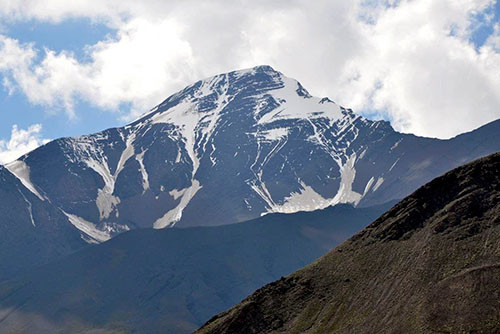
Zafar Peak
On December 3, 2020, the President of the Republic of Azerbaijan issued a decree to mark the liberation of Azerbaijani territories that were previously occupied. This significant achievement, resulting from a 44-day military operation by the Azerbaijan Army, led to the declaration of November 8 as "Victory Day" in Azerbaijan. In commemoration of this event, the unnamed peak with an elevation of 4,301 meters (14,110 ft), located east of Bazarduzu peak, was officially named "Zafar" or "Victory." An expedition was organized, consisting of 13 individuals from the Azerbaijani army and independent climbers, to undertake the challenging ascent in harsh winter conditions. After a 10-day journey, the team successfully reached the summit on February 9, 2021, and installed a specially designed summit board.
You have the option to reserve your place on the Zafar Peak Hiking Tour, which allows you to climb and conquer this remarkable summit.
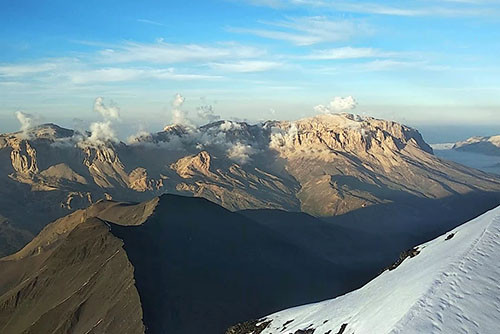
Mount Bazaryurd
Nestled amidst the awe-inspiring mountains of Bazarduzu and Kurvedag in Azerbaijan, the magnificent Mount Bazaryurd stands tall at an elevation of 4,126 meters (13,536 feet) above sea level. What sets this remarkable peak apart is its reputation as one of the more approachable summits among its lofty counterparts exceeding 4000 meters. With a manageable elevation gain of approximately 900 meters from the well-established camps of Bazarduzu, Olympia, and Bazaryurd, this enticing mountain beckons fervent mountaineering enthusiasts, offering an exhilarating and rewarding ascent.
As you ascend Mount Bazaryurd, you'll be treated to an extraordinary tapestry of natural wonders. From rugged cliffs and steep slopes to picturesque valleys and serene alpine meadows, the landscape constantly evolves, offering an ever-changing backdrop that captivates the senses.
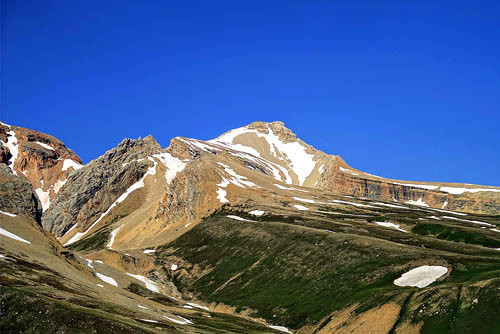
Yarudag Peak
Located in the Shahdag massif, right on the border with Dagestan, Yarudag peak is a remarkable feature of the Azerbaijani landscape. Its lofty elevation of approximately 4,116 meters (13,500 feet) above sea level, along with its impressive relative height of 1400 meters from Shah Yaylag and 1000 meters from Arazdara, contributes to its prominence. Notably, Yarudag peak proudly claims the distinction of being the northernmost four-thousand-meter peak within Azerbaijan's territory.
For those seeking to conquer this majestic summit, the most accessible route is the path that runs parallel to the Azerbaijan-Russia (Dagestan) border. Following this route will lead you to the Yarudag pass, situated just before the Krush pass in Dagestan. Yarudag Mountain's allure lies not only in its impressive altitude but also in the mesmerizing vistas it offers, with sweeping views of the enchanting mountains and valleys that embrace its surroundings.
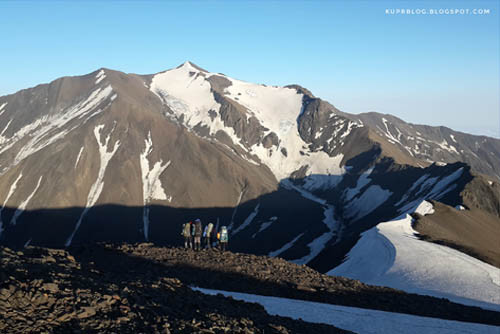
Mount Charundag
Charundag, a magnificent peak standing proudly on the border of Azerbaijan's Gabala region and the Russian border, is a prominent member of the Main Caucasian Range. With an elevation of 4,079 meters (13,382 ft) above sea level, it shares its place among the impressive peaks of Bazarduzu and Ragdan, forming an integral part of the range. Nestled within Charundag's slopes lies the captivating Charun Plateau, while the mountain's allure is further enhanced by a picturesque six-kilometer Charun canyon. The Charun plateau serves as the meeting point of the Charun glacier and the ridge of the Main Caucasian Range. The area also features the adjacent five-kilometer Mullar Canyon, both of which contribute to the natural beauty of the region. The canyons are adorned with cascading waterfalls boasting impressive drops of 7-8 m. Notably, the summit of Charundag plays a significant role as it forms the state border between the Republic of Azerbaijan and the Russian Federation, gracefully tracing along the mountain's top.
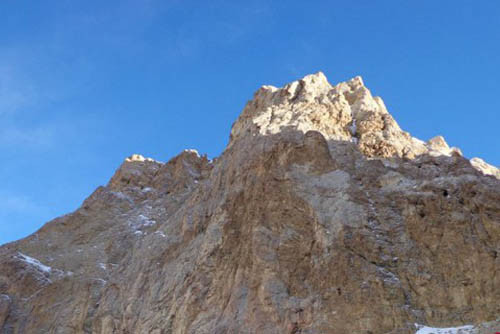
Ataturk Peak And Heydar Peak
The Atatürk Peak, a captivating natural marvel, proudly standing at an impressive elevation of 3,756 meters (12,322 ft) above sea level amidst the enchanting Gyzylgaya Mountain Ridge, near the picturesque Khinalig village in Azerbaijan's Guba region. The peak was officially named "Atatürk Peak", in honor of the extraordinary legacy left by Mustafa Kemal Atatürk.
Adjacent to it, the awe-inspiring Heydar Peak majestically adorns the same Gyzylgaya Ridge, mesmerizing visitors with its remarkable height of 3,751 meters (12,306 ft). In a fitting tribute to former president Heydar Aliyev, the peak was aptly christened "Heydar Peak".
Both Atatürk Peak and Heydar Peak present a breathtaking spectacle of natural beauty, alluring adventurers, climbers, and hikers from around the world. If you want to hike to those summits, you can check Ataturk Peak-Heydar Peak Hiking Tour
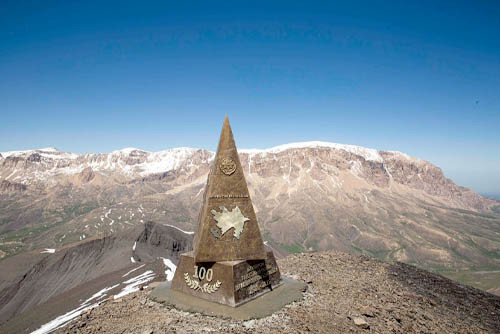
Cumhuriyyet Peak (Republic Peak)
Situated at an impressive elevation of 3,740 meters (12,270) above sea level within the Main Caucasian Range of the South Caucasus, rests the magnificent Cumhuriyet Peak, also known as the Peak of the Republic. This distinguished summit acquired its name in commemoration of the 100th anniversary of the Republic of Azerbaijan, and has rapidly gained popularity among both climbers and adventurers in recent times. Ascending to the summit of Cumhuriyet, one is rewarded with breathtaking vistas encompassing the majestic peaks of Bazarduzu, Bazaryurdu, and Heydar.
The mountain itself appeals to those who seek adventure and have a deep appreciation for nature, providing chances for hiking, climbing, and discovering the captivating natural marvels in the vicinity. If you want to to to the journey of conquerring this Peak you can join Cumhuriyyet Peak Hiking Tour.
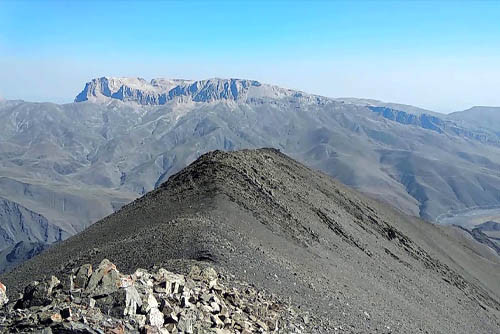
Khinalig Peak
Khinalig Mountain, also known as Khinalug Mountain or Khinalyg Mountain, is indeed located in the Guba region of the Republic of Azerbaijan, specifically in the Main Caucasus range. With an elevation of 3,730 meters (12,303), it is one of the prominent peaks in the area. The mountain is characterized by its geological composition, which consists of clay shales and sandstones dating back to the Jurassic period. These sedimentary rocks provide insight into the ancient geological history of the region and offer valuable information about the environmental conditions that prevailed during that time. The nearby village of Khinalig is renowned for its ancient history and unique cultural heritage. The isolation of the village and its preservation of traditional customs make it an intriguing destination for visitors. The mountain itself attracts adventure enthusiasts and nature lovers, offering opportunities for hiking, climbing, and exploration of the surrounding natural wonders.
If you ever wonder what it's like to reach mountain peaks and see the beautiful scene beneath you unfolding, here's the link to our Khinalig Peak Hiking Adventure Tour.
Tags: Azerbaijan , Greater Caucasus , Tufandag , Shahdag , Mountains , Bazarduzu
Recent Posts
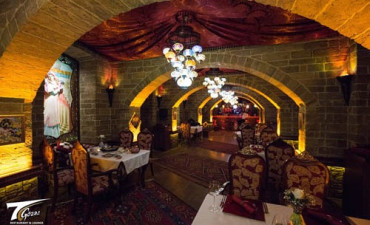
Buy any tour and get 15 percent discount in Baku restaurants

Festivals In Azerbaijan
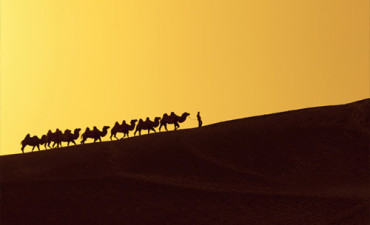
Great Silk Road In Azerbaijan
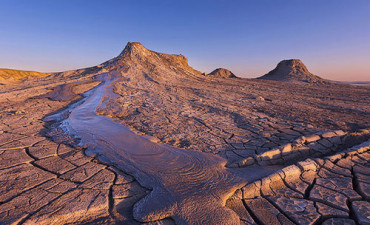
Guide to outdoor activities
